The Microsensor Market is estimated to be valued at USD 38.0 billion in 2025 and is projected to reach USD 149.8 billion by 2035, registering a compound annual growth rate (CAGR) of 14.7% over the forecast period.
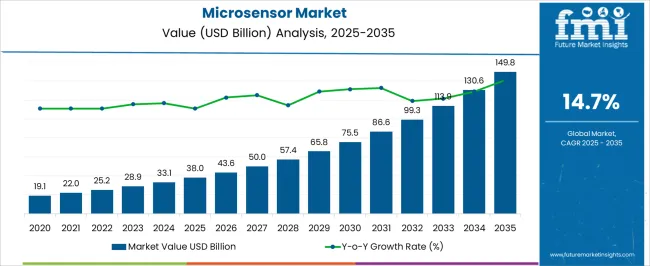
| Metric | Value |
|---|---|
| Microsensor Market Estimated Value in (2025 E) | USD 38.0 billion |
| Microsensor Market Forecast Value in (2035 F) | USD 149.8 billion |
| Forecast CAGR (2025 to 2035) | 14.7% |
The microsensor market is witnessing significant growth, supported by rising demand for miniaturized sensing solutions across a wide range of industries. Increased focus on automation, connectivity, and data-driven decision-making is stimulating adoption, as microsensors play a critical role in enabling real-time monitoring and feedback systems. Advancements in microfabrication techniques and material science are improving performance reliability, energy efficiency, and cost-effectiveness, further expanding their applications.
Integration with Internet of Things platforms, wearable devices, and smart infrastructure is accelerating growth, while increasing investments in research and development are fueling innovation in sensor design and functionality. Growing deployment of electric and autonomous vehicles, industrial automation systems, and consumer electronics is reinforcing demand. Regulatory emphasis on safety, efficiency, and environmental monitoring is also supporting broader adoption.
As industries continue to prioritize digitalization and predictive analytics, microsensors are expected to remain at the forefront of technology adoption The market is therefore positioned for sustained expansion, driven by continuous innovation, expanding end-use applications, and the rising need for compact, precise, and reliable sensing technologies across global markets.
The microsensor market is segmented by types, input signal, verticals, and geographic regions. By types, microsensor market is divided into Micro-Electro-Mechanical Systems (MEMS), Biochips, and Nanosensors. In terms of input signal, microsensor market is classified into Thermal, Radiation, Mechanical, Magnetic, Chemical, and Biological Signals. Based on verticals, microsensor market is segmented into Automotive, Medical, Consumer Electronics, Chemical, and Food And Others. Regionally, the microsensor industry is classified into North America, Latin America, Western Europe, Eastern Europe, Balkan & Baltic Countries, Russia & Belarus, Central Asia, East Asia, South Asia & Pacific, and the Middle East & Africa.
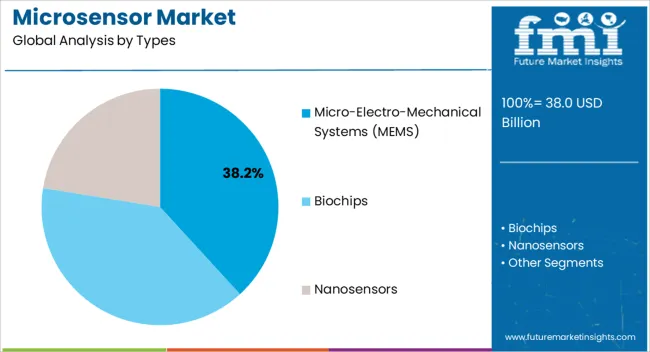
The micro-electro-mechanical systems segment is expected to hold 38.2% of the microsensor market revenue share in 2025, establishing itself as the leading type. Its leadership is being reinforced by its versatility, compact design, and ability to integrate multiple sensing functions within a single platform. These systems offer high accuracy and reliability while consuming minimal power, making them suitable for applications in automotive, healthcare, industrial automation, and consumer electronics.
Advances in microfabrication processes have improved sensitivity and durability, enabling wider adoption in demanding environments. The segment benefits from strong scalability, as mass production techniques reduce unit costs while maintaining precision. Continuous innovation in MEMS technology is allowing integration with wireless communication and artificial intelligence platforms, further broadening use cases.
Demand is being stimulated by the growing need for miniaturized sensors in wearable devices, advanced driver assistance systems, and smart industrial equipment As industries continue to prioritize cost-effective and high-performance sensing solutions, micro-electro-mechanical systems are expected to maintain their dominance in the microsensor market.
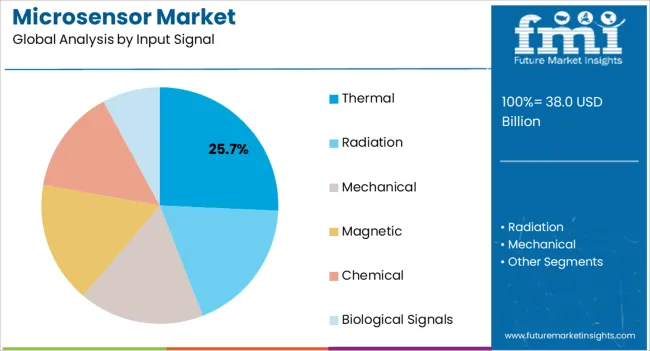
The thermal input signal segment is projected to account for 25.7% of the microsensor market revenue share in 2025, making it the leading input signal type. Growth in this segment is being driven by the increasing need for temperature monitoring and thermal management across diverse industries, including automotive, industrial automation, and consumer electronics. Thermal microsensors are recognized for their ability to provide precise measurements in compact designs, supporting critical functions such as safety monitoring, process optimization, and energy efficiency improvements.
Advancements in microfabrication have led to enhanced response times, sensitivity, and durability, expanding their applicability in challenging operational conditions. The segment is further supported by demand from healthcare applications, where thermal sensing is essential for medical devices and diagnostics.
Integration with IoT platforms and wireless communication is enabling real-time monitoring, making thermal microsensors increasingly valuable in smart infrastructure and connected systems As global industries continue to emphasize operational safety, efficiency, and reliability, thermal microsensors are expected to remain a cornerstone of the microsensor market.
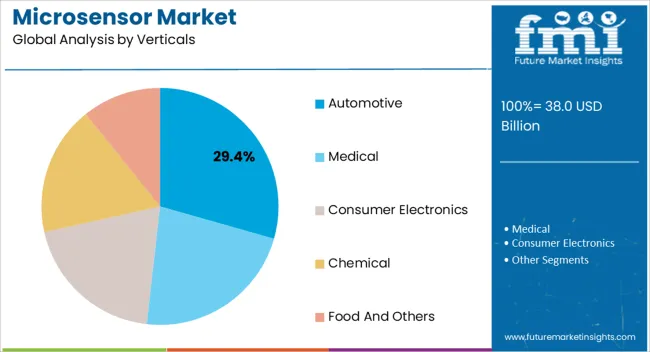
The automotive vertical is expected to capture 29.4% of the microsensor market revenue share in 2025, positioning it as the leading vertical. The dominance of this segment is being driven by the growing incorporation of microsensors in modern vehicles to support safety, efficiency, and automation. Applications such as tire pressure monitoring, collision avoidance, stability control, and advanced driver assistance systems are significantly dependent on compact and precise sensors.
The rising adoption of electric and autonomous vehicles is further boosting demand, as these technologies require extensive sensing capabilities for battery management, navigation, and system optimization. The segment is also benefiting from stricter government regulations mandating enhanced safety and emission controls, which necessitate increased use of microsensors in vehicle design.
Ongoing advancements in MEMS technology, coupled with their cost-effectiveness and durability, are supporting widespread deployment across automotive platforms As vehicles become increasingly connected and software-defined, the reliance on microsensors is expected to deepen, reinforcing the automotive sector’s position as the largest revenue contributor to the global microsensor market.
In recent years, the electronics and semiconductor industries have undergone enormous change, which has led to the creation of novel products. Microsensors with improved detection and quick stimulation have flooded the market as a result of this.
Recent changes in the microsensor market include the creation of novel products and technologies, increasing spending on research and development (R&D), and the formation of fresh alliances between producers of microsensors and other market participants.
Microsensors are widely used in applications, to detect a change in environment and produce a corresponding output signal. These sensors are used in collaboration to improve the functionality of the device they are implemented in. Microsensors are popular because of their small size and low power consumption, hence enterprises are investing in this market to meet customers’ increasing demands.
However while designing circuits, engineers have to be careful about the specifications of the microsensor to achieve the desired response. Microsensors are used in different types of information processing systems, and with the introduction of new technologies such as IoT, their applications will also increase.
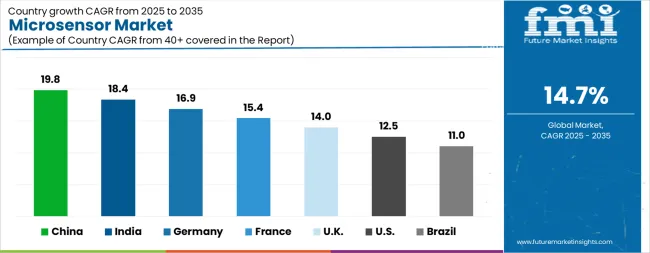
| Country | CAGR |
|---|---|
| China | 19.8% |
| India | 18.4% |
| Germany | 16.9% |
| France | 15.4% |
| U.K. | 14.0% |
| U.S. | 12.5% |
| Brazil | 11.0% |
The Microsensor Market is expected to register a CAGR of 14.7% during the forecast period, exhibiting varied country level momentum. China leads with the highest CAGR of 19.8%, followed by India at 18.4%. Developed markets such as Germany, France, and the U.K. continue to expand steadily, while the U.S. is likely to grow at consistent rates. Brazil posts the lowest CAGR at 11.0%, yet still underscores a broadly positive trajectory for the global Microsensor Market. In 2024, Germany held a dominant revenue in the Western Europe market and is expected to grow with a CAGR of 16.9%. The U.S. Microsensor Market is estimated to be valued at USD 13.1 billion in 2025 and is anticipated to reach a valuation of USD 42.5 billion by 2035. Sales are projected to rise at a CAGR of 12.5% over the forecast period between 2025 and 2035. While Japan and South Korea markets are estimated to be valued at USD 1.9 billion and USD 1.3 billion respectively in 2025.
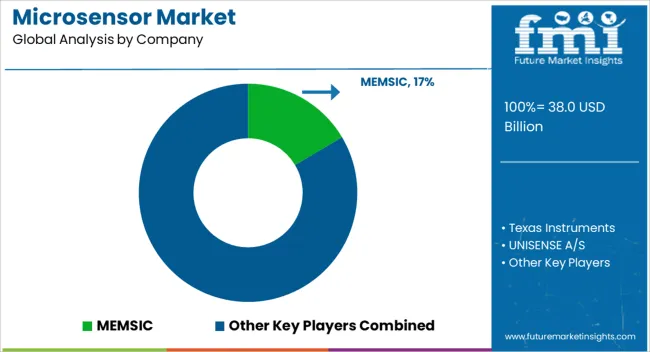
| Item | Value |
|---|---|
| Quantitative Units | USD 38.0 Billion |
| Types | Micro-Electro-Mechanical Systems (MEMS), Biochips, and Nanosensors |
| Input Signal | Thermal, Radiation, Mechanical, Magnetic, Chemical, and Biological Signals |
| Verticals | Automotive, Medical, Consumer Electronics, Chemical, and Food And Others |
| Regions Covered | North America, Europe, Asia-Pacific, Latin America, Middle East & Africa |
| Country Covered | United States, Canada, Germany, France, United Kingdom, China, Japan, India, Brazil, South Africa |
| Key Companies Profiled | MEMSIC, Texas Instruments, UNISENSE A/S, KIONIX, Goertek, OMRON Corporation, STMicroelectronics, Knowles Electronics LLC, NXP Semiconductors, and Robert Bosch |
The global microsensor market is estimated to be valued at USD 38.0 billion in 2025.
The market size for the microsensor market is projected to reach USD 149.8 billion by 2035.
The microsensor market is expected to grow at a 14.7% CAGR between 2025 and 2035.
The key product types in microsensor market are micro-electro-mechanical systems (mems), biochips and nanosensors.
In terms of input signal, thermal segment to command 25.7% share in the microsensor market in 2025.






Full Research Suite comprises of:
Market outlook & trends analysis
Interviews & case studies
Strategic recommendations
Vendor profiles & capabilities analysis
5-year forecasts
8 regions and 60+ country-level data splits
Market segment data splits
12 months of continuous data updates
DELIVERED AS:
PDF EXCEL ONLINE

Thank you!
You will receive an email from our Business Development Manager. Please be sure to check your SPAM/JUNK folder too.
Chat With
MaRIA